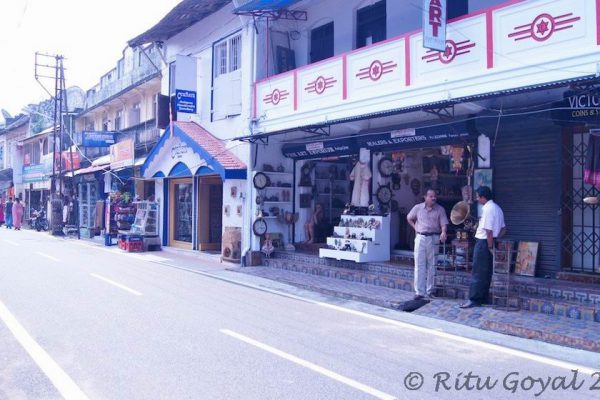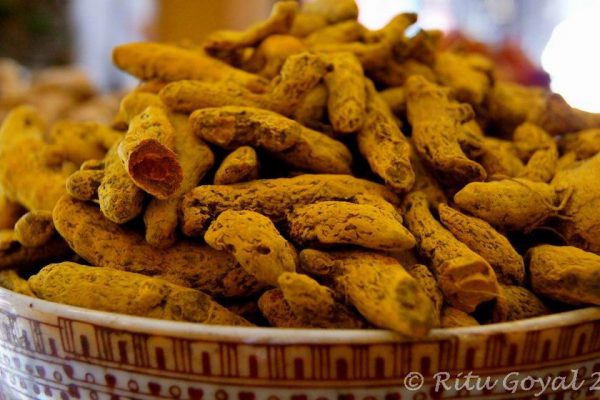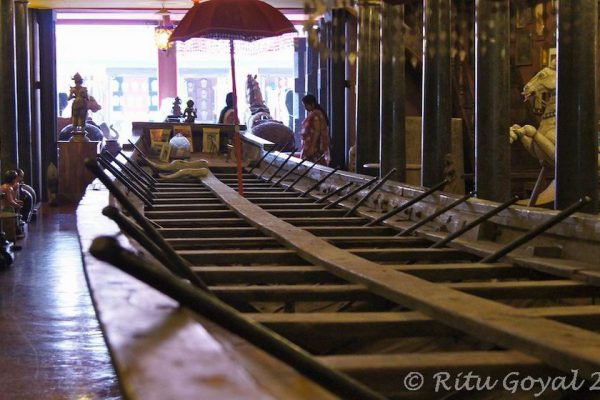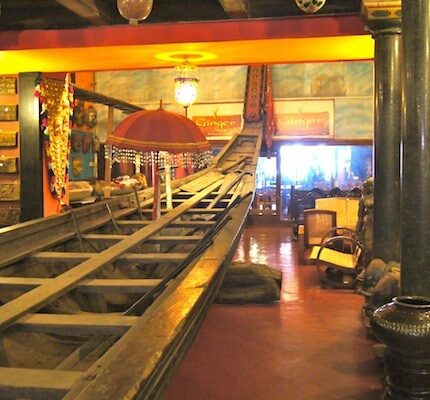
Kerala-Jew Epoch: Inside Jew Town
Jew Town
During our trip to breathtaking Kerala, the stunning Southern Indian State (where we ventured into an exhilarating Tiger Reserve called Gavi), we decided to explore what has been ranked 15th of the 88 things to do in Cochin by Lonely Planet.
Earned its name from the early Jews who eventually settled in Cochin (way back in 700 BC). Most of the settlers either converted to Christianity or left for Israel, but the area has retained its name and its unique identity.
What strikes you at the heart of this locality are the buildings that although exhaustively renovated have not been ‘replaced’…an ailment that has afflicted most old localities of all major cities in India!
The roads, narrow but freshly tarred; the buildings, two storey structures, almost identical, facades settling on the streets, with windows opening into the streets, thatched roofs (to brave the Kerala monsoon), some with tiny balconies overlooking the main street; some painted in vibrant colours, others left dilapidated.
A walk down this street could have transported one back to the days when Jews actually inhabited this area… Now of course, you’d have to have an unwavering ability to turn comatose to even imagine, as you are likely to be inundated with calls of “Madam, please see Kashmir shawls”, “You want to buy jewellery?”, “Come to see exquisite handicrafts”, “Come and look…looking costs nothing…”…and so on and so forth as you saunter past rows of shops exhibiting their wares.
“From Kashmir to Kanyakumari” is often an expression used to describe the unique cultural identity and diverse geographical profile of this vast country…and it is here in Jew Town, the viscera of this port city, that you see the locution spring to life.
From hand crafted shawls, silver jewellery, papier mache produced in the cold climes of the mighty Himalayas, to antiques recovered from traditional old Kerala homes (called Tharavadus), or fabricated in remote towns across the state, to spices and hand-made soaps, and perfumes, crocheted clothes created by last surviving Jewish families, or exquisite hand embroideries (especially the petit point) famous in Kerala as ‘convent embroidery’, and Ayurvedic concoctions, Jew Town is a treasure trove of goodies that will leave you spoilt for choices.
But Jew Town wasn’t always like this.
Once upon a time, not very long ago, a flourishing trading market existed in the innards of Cochin, known to be the largest spice trading market in the sub continent. Smell of pungent spices – Black pepper, cinnamon, cardamom, dry ginger, turmeric, clove, nutmeg – wafted through the lanes of this bustling bazaar where the home grown spices were cleaned, packed and sold (locally & exported). But that was in the 1990s.
By early 21st century, the traditional spice businesses began shutting down due to several reasons, one among them being the intense competition from other spice producing nations. Indian spice kings lost their crowns, thrones and veritable empires. The once-enterprising bazaar wore a deserted look for a few years before the winds of change came knocking once again.
Tourism happened to God’s Own Country and the rest they say, is history!
So what else can we do while in Jew Town, you ask?
You could go and see the Paradesi Synagogue, which was originally built in 1568 and where prayers are still held.
According to legend, the history of Kerala’s Jews goes back as far as the time of King Solomon (10th century BC), when trade in exotic items from India such as peacocks, ivory, sandalwood and spices flourished.
The Jewish community in and around Cranganore enjoyed amicable relationships with local rulers. It grew and prospered over the centuries, building several synagogues. In 1524, because of conflicts with the Portuguese and Arab Moors, they were forced to flee from Cranganore to Cochin. They found protection under the Hindu Raja, who granted them land adjacent to his own palace for a town that became known as “Jew Town”.
Beginning in the early 16th century there was a new migration of Jews to Kerala. Some of the newcomers were Sephardic Jews, direct and indirect refugees from the Spanish and Portuguese expulsions, who came to India by way of Aleppo, Constantinople, and the Land of Israel. Others were from Iraq, Persia, Yemen, and Germany.
In 1568 the Jewish newcomers, who were subsequently called Paradesis (“foreigners” in Malayalam), built a synagogue of their own next to the Maharaja’s palace in Cochin. They adopted the Malayalam language and identified enthusiastically with Kerala customs and traditions, but at some point they stopped marrying the Jews who had been there many centuries before them.
In written accounts (especially by Western visitors) the Paradesis often were referred to as “white Jews” and the more ancient Malabari communities as “black Jews,” though there is not always a clear distinction between them in terms of skin color. (Source: www.myjewishlearning.com)
According to Parayilat a blog we chanced upon during our research, the tiny existing Jewish community lost another member in October 2012 leaving just 8 Jews in Cochin – 2 men and 6 women, most over 70 years old! This community is on the verge of perishing and alongwith it, a slice of history, will too.
You could ALSO go take a peek at the World’s Largest Varpu!
Do not mistake the traditional Varpu from Kerala with the baby name that is popular in Finland (and stands for Berry Brush). This Varpu is a large low bronze cauldron similar in form to an uruly used as a cooking vessel for feasts in India. These vessels are often made by the skilled metalworkers of Kerala (mostly from Mannar, a small town located in the Alappuzha district) using the traditional cire perdue method.
This Varpu (almost 3 meters in diameter) located in an antique store in Jew Town has made it to the Limca Book of Records. The interesting facts about this hand-made metal Uruly are available on their website (www.crafters.in)
You could marvel at the sheer size and longevity of a 100 year old Snake Boat on display at one of the antique stores.
Snake boats called Chundanvallams dominate boat races that is one of the major water sports in Kerala. Boat races are steeped in tradition; some date back to an ancient era and have different myths and legends connected to them. It is also widely known that in the bygone era, disputes between kings were settled by boat races!
Races are held in different areas and water bodies of the state witnessing widespread participation from teams that hail from across Kerala. Most races are organised during temple festivals, which renders an atmosphere of religiousness to this competitive sport.
You could shop.
From antiques, artefacts, handicrafts to furniture, Jew Town is a shopoholic’s paradise.
You could sit in one of the waterfront restaurants/cafes enjoying the view of the backwaters. Restaurants offer standard fare – South Indian, Chinese, Moghlai, North Indian, Italian, including a large variety of seafood.
You could partake in the joy of strolling down the narrow streets, marvelling at the architecture that is very Jewish. Not all buildings have been renovated. Some exist in ramshackled state standing the test of time.
Things to remember
Most of the goods sold in the bazaar are a tad overpriced. Some store keepers hike up the prices for foreign tourists. Bargain. Other than in stores selling spices, the prices elsewhere are not fixed.
The Synagogue is closed on Fridays, Saturdays and other Jewish holidays. On other days it is open from 10 am to 12 noon, and 3 – 5 pm.
The Synagogue follows a strict dress code for men and women. Sleeveless shirts, shorts, skirts and the like are not permitted inside the Jewish temple.
Photography is also prohibited inside the temple.
Beware of touts and agents who force you to shop at a particular store. Even when part of a guided tour, feel free to explore and shop at your desire. India IS a democracy afterall!
Useful Links
When visiting Kerala do browse through the Kerala Tourism website for details on destinations, planning an itinerary etc.
The Kerala Tourism Development Corporation (KTDC) website is a wonderful place to begin exploring stay options run and/or managed by this government organisation. Some of their properties are located in exceedingly picturesque areas.
Ritu@2017 January 3, 2013












